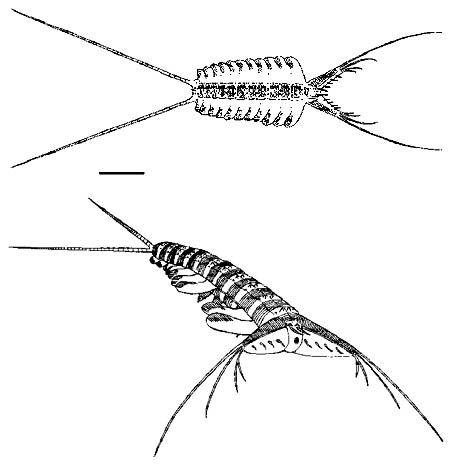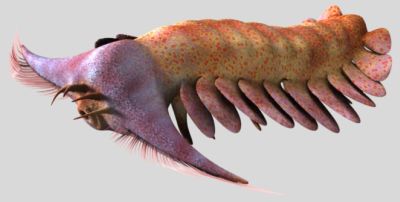
Pambdelurion
| Palaeos |  |
Dinocaridida |
| Ecdysozoa | Kerygmachela and Pambdelurion |
| Page Back: Dinocaridida | Unit Up: Ecdysozoa | Unit Home | Clade Up: Panarthropoda | Page Next: Opabinia |
| Unit Back: Onychophora | Clade Down: Arthropoda | Dendrogram | References | Unit Next: Arthropoda |
|
Abbreviated Dendrogram
PANARTHROPODA `==Siberiidae | `--DINOCARIDIDA |--Kerygmachela `--+--Pambdelurion `--+--Opabinia `--+--Anomalocarididae | |--Hurdia | `--+--Anomalocaris | `--Laggania `--+--Schinderhannes `--ARTHROPODA |
Contents
Overview |
Note: unless otherwise indicated, the following is from Chris Clowes Peripatus website
The Sirius Passet fauna (named after the Sirius sledge patrol that operates in North Greenland) derives from the Buen Formation, exposed on the eastern shore of J.P. Koch Fjord in the far north of Greenland.
The fauna is inevitably compared to that of the Burgess Shale, although it is probably ten to fifteen million years older – 518 vs. 505 Ma (Martin et. al. 2000) – and more closely contemporaneous with that from Chengjiang.
The Sirius Passet soft-body fossils are found in rocks of the Lower Cambrian Buen Formation, in mud shales, representing a rather deeper water facies than the Burgess Shale, formed on the outer continental shelf, off-shore from a carbonate escarpment. "Large chunks from the edge of the carbonate platform occasionally fell or slid into the adjacent basin, where the Sirius Passet fauna lived" (Conway Morris 1998, p. 117).
In general, preservation of the Sirius Passet fossils is not spectacular.
Discussion of early metazoan evolution has for many years been dominated by fossil evidence from the Middle Cambrian Burgess Shale and, in particular, by its famous problematic arthropods – Anomalocaris, Leancoila, Opabinia, and so on. "No one would dispute that these fossils are problematic, in the sense that they are difficult to understand. However, that methodological difficulty should not be confused with the possibility that these fossils have only remote affinities with all living groups" (Budd 1997, p.125).
The Sirius Passet fossils are approximately ten to fifteen Ma older than those of the Burgess Shale, presenting us with an even earlier window upon metazoan evolution; a glimpse of forms which, if anything, are even more challenging to interpret.
As in the Burgess Shale, arthropods are the most abundant component of the Sirius Passet fauna although there is only one or two species of trilobite whereas, in the Burgess Shale, there are twelve or so. In fact there are generally few taxa having shelly skeletons; the trilobites, "rare hyoliths, a number of sponges with prominent spicules, a few small brachiopods, and no echinoderms or molluscs" (Conway Morris 1998, pp. 120-121). Of the arthropods lacking calcified exoskeletons, some are somewhat – but not markedly – similar to Burgess Shale species. Many are large, reaching 50 cm or more in length. In addition there are a number of polychaete annelids and large priapulids (ibid.) - Chris Clowes 2002
The two species of so-called "gilled lobopods" from the Sirius Passett Lagerstätte - Kerygmachela and Pambdelurion - both combine anomalocaridid-like imbricated lateral body flaps with lobopodian trunk limbs. Their mouthparts however are quite distinct; Kerygmachela retains the ancetsral terminal mouth cone as in cycloneuralian worms and Cambrian xenusian lobopods, whereas Pambdelurion posesses an anomocaridid-like ventral mouth consisting of a circlet of overlapping plates with denticles along their inner margin (Edgecombe 2009). In comtrats to the unambigiously radiodontan and dinocaridid Pambdelurion, Kerygmachela posesses a typical mosaic mix of primitive and advanced features, showing it to be a true transitional form. MAK120507

Kerygmachela kierkegaardi Budd 1998
Horizon: Buen Formation, Sirius Passett Lagerstätte of Greenland. Early Cambrian (Atdabanian age)
Phylogeny: Dinocaridida : (Pambdelurion + (Opabinia + (Anomalocarididae + (Schinderhannes + (Parapeytoia + Arthropoda))))) + *
Characters: Trunk exites as lateral lobes; heteronomous annulation. (Daley et al 2009 cladogram, supplement fig S3)
Description: The cephalic region is characterised by a pair of stout unsegmented appendages each bearing long spinose processes, and an anterior mouth. The trunk shows alternating rows of tubercles and transverse annulations along the axis, to which are attached 11 pairs of gill-bearing lateral lobes and lobopodous limbs. The caudal region is small, and bears two long tail spines. There is some evidence for circular musculature arranged around the trunk and a dorsal, longitudinal sinus, and several details of the muscular pharynx have been preserved. - Chris Clowes 2002
Comments: The combination of characters found in Kerygmachela allows it to be allied with the lobopods, represented in the extant fauna by the onychophorans, tardigrades, and possibly the pentastomids, and in the Cambrian fossil record by a morphologically diverse set of taxa, some of which are not assignable to the extant groupings. It also shares important characters with the problematic Burgess Shale forms Opabinia regalis Walcott and Anomalocaris Whiteaves, and another Sirius Passet form, Pambdelurion Budd. These taxa together form a paraphyletic group at the base of the clade of biramous arthropods.
"In the Sirius Passet, the putative lobopod Kerygmachela shows marked similarities to Burgess Shale Leanchoilia, suggesting an alternative interpretation for its axial structure. I argue here that most three-dimensionally preserved axial structures in Burgess Shale-type arthropods can be interpreted as well developed midgut diverticula. Such a condition is characteristic of living carnivorous arthropods and provides a key to interpreting the ecology of ancient forms" (Butterfield 1999). Chris Clowes 2002
Kerygmachela lacks almost all of derived arthropod features apart from lateral flaps (a precursor to biramous limbs (Budd 1996) and heteronomous annulation. The terminal mouth (a primitive/ancetsral ecdysozoan feature) shows that the ventral mouth in both onychophorans and arthropods can be seen to be a convergence Budd 2001
Image: Reconstructions of Kerygmachela kierkegaardi from Budd 1998.

Pambdelurion whittingtoni Budd 1997
Horizon: Buen Formation, Sirius Passett Lagerstätte of Greenland. Early Cambrian (Atdabanian age)
Phylogeny: Dinocaridida : Kerygmachela + ((Opabinia + (Anomalocarididae + (Schinderhannes + (Parapeytoia + Arthropoda)))) + * )
Characters: a representative ancestral form, important synapomorphies are shared with other protoarthropods. These include: ventral Peytoia-like mouth (circumoral plates; also shared with Megadictyon), trunk appendage flaps in the form of lateral lobes (shared with Kerygmachela, Opabinia, and Anomalocaridids); cuticularized, sclerotized, or arthropodized frontal appendage (shared with Opabinia, Kerygmachela, Jianshanopodia, Megadictyon, and anomalocaridids). MAK120507
Description: "almost 30 cm length, its ventral mouth being armed with cuneiform plates, 11 pairs of flaps along the body, and possibly two or three additional flaps in the head region (Budd 1997). Limbs bearing about fifty annuli were present in conjunction with lateral flaps. In these respects it occupies, together with anatomically more advanced coeval Kerygmachela, an intermediate position between xenusians with grasping anterior appendages and the more typical anomalocaridids." - Dzik 2011
Artwork: Graphic from by Senzakitatsuya's Cambrian Cafe (in Japanese)
| Page Back: Dinocaridida | Unit Home | Page Top | Page Next: Opabinia |
page uploaded 15 July 2002, original last modified: 21 Apr 2002, checked ATW051108. Content © Chris Clowes 2002 Original url. Page revised and additional material added MAK120507, all content signed MAK is Creative Commons Attribution